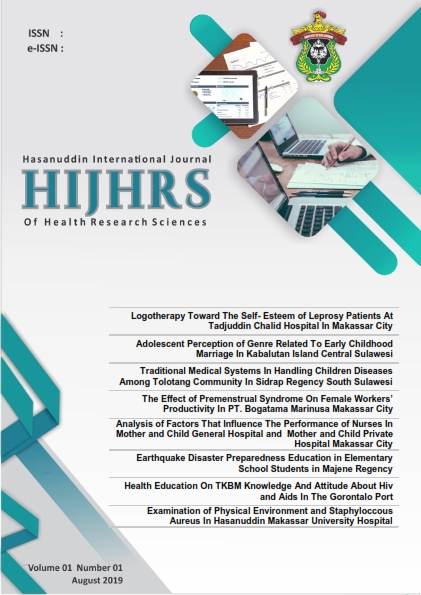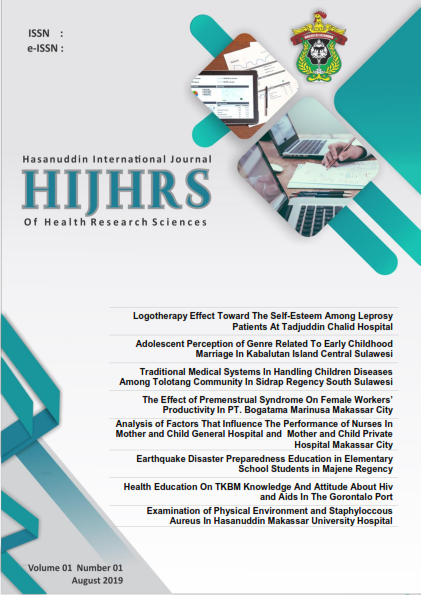Examination Of Physical Environment and Staphylococcus Aureus In Hasanuddin Makassar University Hospital
Abstrak
ABSTRAK
Humans need some main material for survival, one of which is air. The physical environment and air quality of a hospital room that does not meet health requirements can cause health problems for patients, workers who work in hospitals or visitors to hospitals. Be aware of the effects that bacteria will cause in the air on the environment and human health. So it is necessary to do a physical examination so that prevention and control efforts can be carried out properly. This study aims to determine the quality of the physical environment (temperature, humidity, and lighting) and identification of Staphylococcus aureus air bacteria in three rooms on an outpatient installation at Hasanuddin University Hospital. This research is an observational elite with cross-sectional approach. The population this study were all Staphylococcus aureus bacteria identified in the cup. The method of this research is direct measurement at the location of the study consisting of identification of the presence of Staphylococcus aureus bacteria, temperature, humidity, and lighting. Sampling was done by researcher own, Staphylococcus aureus bacteria examination carried out by a third expert Bacteriological Laboratory Medical Faculty of Hasanuddin Makassar. The results of this study indicate the quality of the physical environment of temperature and humidity is still not appropriate if you look at the standard requirements for environmental health of the Hospital, but for the lighting parameters are in accordance with the standards. Then to identify the bacteria showing the results of the entire room, there are Staphylococcus aureus bacteria. Conclusion that the examination of the physical environment and identification of air bacteria in Hasanuddin University Hospital has not met the standards and the presence of Staphylococcus aureus bacteria. Recommended that the Hospital be more able to apply disinfectant, especially in rooms in outpatient installations.
Keywords: Physical Environment, Temperature, Lighting, Humidity, Staphylococcus aureus.
Referensi
Abdullah M.T. & Hakim B.A. (2011). Lingkungan Fisik dan Angka Kuman Udara Ruangan di Rumah Sakit Umum Haji Makassar, Sulawesi Selatan. Jurnal Kesehatan Masyarakat Nasional. Fakultas Kesehatan Masyarakat Universitas Hasanuddin, 5(5):07-211.
Dacarro C.A.M., Picco P., Grisoli. & M Rodolfi. (2003). Determination of aerial microbiological contamination in scholastic sports environments. Journal of applied microbiology, 95(5): 904-12.
Dwi Cahyani V. (2016). Kualitas Bakteriologis Udara Dalam Ruang Perawatan Inap Rsud H. Padjonga Daeng Ngalle Kabupaten Takalar. Jurnal Jurusan Biologi Fakultas Sains dan Teknologi UIN Alauddin Makassar, 22(3):155-160.
Departemen Kesehatan RI. 2002. Keputusan menteri kesehatan republik Indonesia nomor 1335/MENKES/SK/X/2002 tentang standar operasional pengambilan dan pengukuran sampel kualitas udara rumah sakit. Jakarta.
Fitria L., Wulandari R.A., Hermawati E., & Susanna D. (2008). Kualitas Udara Dalam Ruang Perpustakaan Universitas “X” Ditinjau Dari Kualitas Biologi,
Fisik, Dan Kimiawi. Jurnal Makara kesehatan, Universitas Indonesia, 12(2):7-83.
Harun H., Probandari A. & Darmanto. (2017). Evaluasi Standar Kualitas Higiene Dan Sanitasi Di Instalasi Bedah Sentral Rumah Sakit Umum Daerah (Rsud) Wates. Jurnal Ilmiah Praktisi Kesehatan Masyarakat, 2(2):3-12.
Jawetz, MA. (2005). Medical Microbiology. Salemba Medika. Jakarta.
Lantang D. & Paiman D. (2012). Bakteri Aerob Penyebab Infeksi Nosokomial Di Ruang Bedah RSU Abepura, Kota Jayapura, Papua. Jurnal Biologi Papua, 4(2):63-68.
Muntaha R. & Caesar D.L. (2016). Faktor Lingkungan Fisik Ruangan Dengan Angka Kuman Udara Ruang Rawat Inap Gedung Siti Hajar Rumah Sakit Islam Sultan Hadlirin Jepara. Jurnal Keperawatan dan Kesehatan Masyarakat Cendekia Utama, 1(5):97-103.
Palawe B.V., Kountul C. & Waworuntu O. (2015). Identifikasi Bakteri Aerob Di Udara Ruang Operasi Instalasi Bedah Sentral (Ibs) Rsup Rof. Dr. RD Kandou Manado. Jurnal e-Biomedik, 3(3):827-833.
Raharja M. (2015). Kualitas Angka Kuman Udara Pada Ruang Persalinan Praktik Bidan Swasta Di Kota Banjarbaru. Jurnal Kesehatan Lingkungan, 12(2): 284-290.
Rachmatantri I., Hadiwidodo M. & Huboyo H.S. (2015). Pengaruh Penggunaan Ventilasi (Ac Dan Non-ac) Terhadap Keberadaan Mikroorganisme Udara Di Ruang Perpustakaan (Studi Kasus : Perpustakaan Teknik Lingkungan Dan Perpustakaan Biologi Fakultas Mipa). Jurnal Teknik Lingkungan, 4(1):1-13.
Shiferaw T., Beyene G., Kassa T. & Sewunet T. (2013). Bacterial contamination, bacterial profile and antimicrobial susceptibility pattern of isolates from stethoscopes at Jimma University Specialized Hospital. Annals of clinical microbiology and antimicrobials, International Journal of Infection Control. Ethiopia, East Africa. 12(1):1-8.
Waluyo, L. (2009). Environmental Microbiology. UMM Press: Muhamamadiyah University Malang.
Wulandari E. (2013). Faktor Yang Berhubungan Dengan Keberadaan Streptococcus Di Udara Pada Rumah Susun Kelurahan Bandarharjo Kota Semarang. Unnes Journal of Public Health, 2(4):1-9.
Wikansari N. (2012). Pemeriksaan Total Kuman Udara Dan Staphylococcus aureus Di Ruang Rawat Inap Rumah Sakit X Kota Semarang. Jurnal Kesehatan Masyarakat Universitas Diponegoro, 1(2):384–392.
Unduhan
Diterbitkan
Terbitan
Bagian
Lisensi



